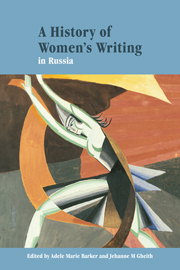Book contents
- Frontmatter
- Contents
- Notes on contributors
- Acknowledgments
- Note on transliteration
- List of abbreviations
- Introduction
- 1 Women's image in Russian medieval literature
- 2 Sappho, Corinna, and Niobe: genres and personae in Russian women's writing, 1760–1820
- 3 The inexperienced muse: Russian women and poetry in the first half of the nineteenth century
- 4 Women of the 1830s and 1850s: alternative periodizations
- 5 “A particle of our soul”: prerevolutionary autobiography by Russian women writers
- 6 The women of Russian Montparnasse (Paris, 1920–1940)
- 7 Women in Russian Symbolism: beyond the algebra of love
- 8 The eastern path of exile: Russian women's writing in China
- 9 Realist prose writers, 1881–1929
- 10 Women and gender in post-symbolist poetry and the Stalin era
- 11 Writing the female body politic (1945–1985)
- 12 In their own words? Soviet women writers and the search for self
- 13 Women's poetry since the sixties
- 14 The persistence of memory: women's prose since the sixties
- 15 Perestroika and post-soviet prose: from dazzle to dispersal
- Bibliographical guide to writers and their works
- Guide to further reading
- Index
7 - Women in Russian Symbolism: beyond the algebra of love
Published online by Cambridge University Press: 22 September 2009
- Frontmatter
- Contents
- Notes on contributors
- Acknowledgments
- Note on transliteration
- List of abbreviations
- Introduction
- 1 Women's image in Russian medieval literature
- 2 Sappho, Corinna, and Niobe: genres and personae in Russian women's writing, 1760–1820
- 3 The inexperienced muse: Russian women and poetry in the first half of the nineteenth century
- 4 Women of the 1830s and 1850s: alternative periodizations
- 5 “A particle of our soul”: prerevolutionary autobiography by Russian women writers
- 6 The women of Russian Montparnasse (Paris, 1920–1940)
- 7 Women in Russian Symbolism: beyond the algebra of love
- 8 The eastern path of exile: Russian women's writing in China
- 9 Realist prose writers, 1881–1929
- 10 Women and gender in post-symbolist poetry and the Stalin era
- 11 Writing the female body politic (1945–1985)
- 12 In their own words? Soviet women writers and the search for self
- 13 Women's poetry since the sixties
- 14 The persistence of memory: women's prose since the sixties
- 15 Perestroika and post-soviet prose: from dazzle to dispersal
- Bibliographical guide to writers and their works
- Guide to further reading
- Index
Summary
Introduction: on signs, functions, and celebrated equations
“The wife of [Aleksandr Aleksandrovich Blok] and suddenly … !” they knew what I should be like, because they knew what “function” I was equal to in the equation of the poet and his wife. But I was not a “function.” I was a human being, and I myself often didn't know what I was equal to, let alone what was equal to the “wife of a poet” in the celebrated equation. It was often the case that I was equal to nothing; and thus I stopped existing as a function and went off into my own “human” existence.
LIUBOV' MENDELEEVA-BLOK, I byl', i nebylitsy o Bloke i o sebe (Facts and Myths About Blok and Myself)Many of the women who occupy a place in western histories of Russian Symbolism do so not because they distinguished themselves as poets or writers in their own right, but rather because they fulfilled important “functions” in the “celebrated equations” of male poets. To be sure, most students of Russian literature can without much difficulty elaborate on the ways in which Liubov' Mendeleeva-Blok and Lydiia Zinov'eva-Annibal fulfilled the “wife-function” and “muse-function” for Aleksandr Blok and Viacheslav Ivanov respectively or even how Nina Petrovskaia fulfilled the “muse-function” for Valerii Briusov and Andrei Belyi, but they are much less likely to be familiar with the memoirs, plays, poetry, and short stories of these women.
- Type
- Chapter
- Information
- A History of Women's Writing in Russia , pp. 134 - 152Publisher: Cambridge University PressPrint publication year: 2002

